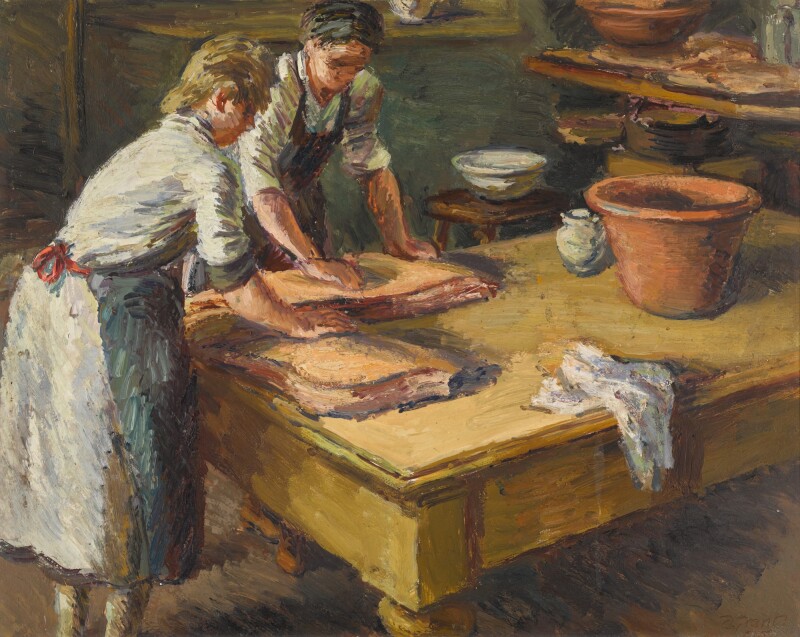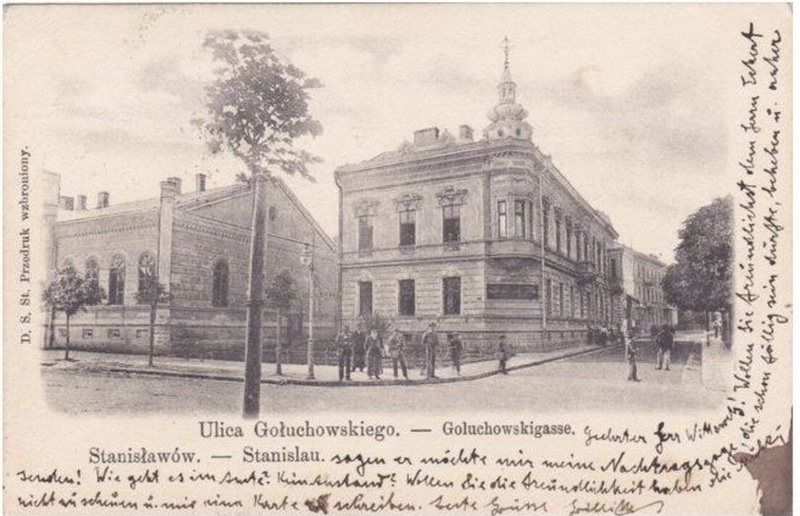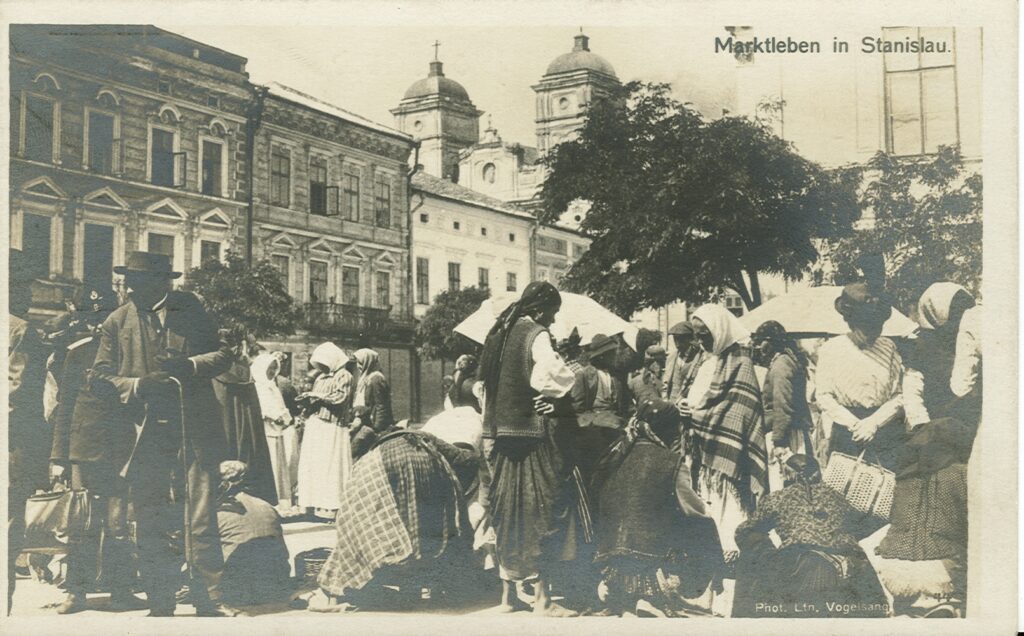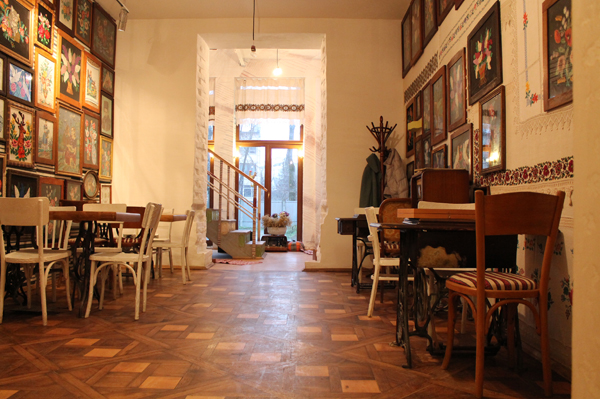
Stefaniia Muliarova is one of the faces of Ivano-Frankivsk. A female legend and cultural heroine without mentioning whom no conversation about Galician cuisine is complete. Her memory is preserved by the family restaurant “Dim Muliarovykh” (House of the Muliarov Family), which continues the traditions of culinary diversity of Galician cuisine.
Roksolana Zharkova, a writer, literary scholar and critic, explains why food can be similar to love and poetry.
While on Chornovola Street, pay your attention to the elegant old tenement house from the times of the Austro-Hungarian Empire. This house was built back in 1909 for the wealthy family of local lawyer Isaac Goldfeld. For more than a century, these walls have been absorbing the flavors of delicious meat and fish dishes, the fragrance of herbal teas, the tartness of tinctures and liqueurs, and the hot steaming of fruit and berry pastries. Stefaniia Muliarova, Goldfeld’s daughter-in-law and a Hutsul, who became famous for her wonderful culinary skills throughout the city and the surrounding area, used to live here.
With the knowledge of the peculiarities of many national cuisines, Stefa created amazing dishes according to her original recipe. Each of Stefania’s dishes is a whole world of thick colors and smells, subtle flavors and delicacies, sweet sauces and salty gravies, tones and subtones that harmoniously formed into the perfect music of tasting and savoring of the first quarter of the 20th century.

Goldfeld’s house
What do we know about Galician cuisine?
The history of Galician cuisine is the formation and prosperity of a regional gastronomic tradition, in which one can feel influences of Polish, Jewish, Armenian, Hungarian, and German cultures of cooking and consuming food.
In 1910, the book Home Cuisine. How to Cook and Bake by Leontyna Luchakivska, a resident of Ternopil, was published in Lviv and became the first Ukrainian-language bestseller cookbook. The then Lviv newspaper Dilo noted on its pages:
“This is the first Ruthenian cookbook, from which every Rusyn woman can learn how to cook and bake the most diverse dishes for all seasons, and besides, very tasty and cheap, and bake all kinds of delicious and also cheap pastries.”
The collection includes 455 recipes collected in 17 sections (Brines and Soups; Sauces for Meat Dishes; Meat Dishes; Pâtés, French and Shortcrust Pastry for Pâtés; Veggies; Compotes; Salads; Ice Сream, etc.). There are both the simplest dishes and those that require specific ingredients (chamois, venison, guinea fowl, quail, etc.). The recipes represent not only Galician, but also Bukovyna, Jewish, Austrian, Polish, French, and Italian cuisine.
The work The First Ukrainian General Practical Cuisine by Olha Franko (Bilevych), the daughter-in-law of the writer Ivan Franko, the wife of his son Petro, published in 1929 in Kolomyia, is of fundamental importance in the development of Ukrainian culinary art. It was Olha Franko who formalized the records of Galician cuisine and gave practical advice in the publication National Cuisine (Lviv, 1937) regarding the cooking of breakfast, lunch and dinner by housewives.
It is impossible not to mention Dariia Tsvek, a Galician author of such books as Sweet Pastries, For the Festive Table, On Weekdays and Holidays, etc. (the 1960s). In the Sweet Pastries collection, Dariia Tsvek provides not only exclusive recipes for dough products but also useful recommendations for decorating cakes, pies, rolls, and cookies. The author seems to be conducting a virtual master class where she shows how to make creams, fillings, fudges and toppings; cook jams, preserves, and marmalades; experiment with sweet salads; pour jelly and make homemade ice cream.
It is also worth mentioning the contemporary collection by Yurii Vynnychuk titled Galician Cuisine. History, Recipes, and Faces (The Old Lion Publishing House). Under one cover, the writer collected the family recipes and gastronomic stories of Taras Chubai, Kuzma Skriabin, Nataliia Ivanychuk, Pavlo Sheremeta, Yevhen Hlibovytskyi, Taras Prokhasko, Mariana Savka, Oksana Karavanska, Oleksandra Koval and others.
Another collection Recipes of Galician Cuisine by Larysa Karavaieva contains popular recipes of skillful Galician housewives (Olha Franko and Dariia Tsvek, as well as modern cooks).
Because Galician cuisine is, first of all, about fresh, healthy and high-quality products of animal and plant origin, home-grown vegetables, fruits, and greens. Cooking its dishes is cost-saving and the dishes themselves are hearty and nutritious, often with the addition of overseas spices and seasonings. The aesthetics of food consumption is a fastidious selection of tableware, cutlery, tablecloths, and napkins. There were rumors that young girls in Galicia, ‘young marriageable ladies’, often kept albums with culinary recipes instead of romantic diaries. Stefa Muliarova also had such a notebook.
Mrs. Muliarova’s Recipe Book: can cuisine be poetic?
For a long time, the Goldfeld’s house hid many secrets in its nooks. During its redevelopment, the construction workers came across a niche in the wall where private photos, a comb, newspaper clippings, and recipe records were once hidden. It is not hard to understand that all those things belonged to legendary Stefa. This is how the story of the “Dim Muliarovykh” Museum Restaurant began (as described in the book titled Mrs. Muliarova’s Recipe Book by Olha Derkachova, the writer from Ivano-Frankivsk, who talked to Iryna Fishchuk, the co-founder of the family restaurant).
Inspired by the character of Stefaniia, this book is based on the local studies of Olena Buchyk and Ivan Bondarev, some oral stories, archival documents, memories, etc. Having thoroughly studied the materials about Muliarova, Olha Derkachova and Iryna Fishchuk created not just an artistic biography, but rather a whole novel about a charismatic cook who
“when entering the kitchen, feels like the conductor of a great symphony orchestra, like an alchemist turning mercury into gold, like a poet writing the first, still hesitant words on a blank page.”
A passionate rebel and culinary fairy
Some compare Muliarova with Stefaniia Chornenko, a character in the famous novel Felix Austria by Sofiia Andrukhovych. Indeed, these heroines have much in common: both were from Stanislaviv, both cooked deliciously and presented the gastronomic culture of the Ukrainian city of the Austro-Hungarian times. However, these women should not be identified with each other because each of them had her own mission.
In Mrs. Muliarova’s Recipe Book, we see the image of an emancipated woman who realizes her desires and strives for self-realization and success. Young and ambitious, romantic and sensitive, Stefa dreams of a bicycle, but “bicycles are not for respectable wealthy ladies”, as her environment convinces her. Also, as great moralizers warn,
“there’s no reason for a girl to spend time with a book. Because no one is wooing you anyway, they are afraid that you are too smart.”
But Stefa was wooed, even though she was smart, and even more, she married into a family from Stanislaviv. But even there the young woman had no peace. The Hutsul daughter-in-law is ridiculed by Mrs. Goldfeld both for her culinary talent and her figure. Because “kitchen is the fetish of the young daughter-in-law of lawyer Isaac Goldfeld and the eternal complaints of her mother-in-law” who for some reason stubbornly “doesn’t let her into the kitchen saying that Stefaniia will not cook there but eat.” And although the woman “is quite comfortable with herself, her mother-in-law hints several times that she eats too much and that she needs more and more fabric for her dresses.”

Stefa and her husband
But Stefa was not sad about that, except that she ran away from the Goldfeld’s house several times. But later, she came back again because she longed for her husband and promised herself that “she will never run away again because what if next time her beloved will walk around the yard and suddenly go crazy. The health of today’s men is no good.” Stefaniia had an ironic attitude to life, a good sense of humor, and was a dedicated friend. Dialogues between Stefaniia and her friend Zosia were often comical:
— It’s nice to be married, isn’t it?
— It depends. But I like it.
— And is it true that you ran away from your husband?
— True, but I was away only for a while.
— I wouldn’t run away.
— Get married first and then we’ll talk, — Stefaniia hugged Zosia by the shoulders.
Stefaniia is a type of modern feminist who values her freedom and protects the boundaries of her intimacy.
She opposes the traditional patriarchal idea of the role and place of a woman in society convincing that a woman should love and be loved, while at the same time freely managing her life (riding a bicycle, going to tennis courts, reading plenty of poems by French poets and Polish romantic novels, traveling, resting, having her labor of love, and developing in that field), and not obey to one’s whimsical laws.
Stefaniia also advises other women: “She loved her husband. She liked to feel the touch of his cheek at night, the bliss of love when it was so sweet that she couldn’t sleep, the smell of morning coffee afterwards, the feeling that she was not alone in this world. But why does a young lady have to get married?! Stefaniia could not understand that. Who came up with these mandatory rules that make unmarried young ladies turn pale and faint from the horror that another year has passed and no one has married them yet?! Marriage is a very individual thing. Well, you can’t rush into marriage just because you have to, without even properly looking at who you’re marrying.”
According to Stefa, love should make a woman happy, should taste like a fragrant dish with duck and parmesan, a tender apple pie, a juicy chicken roulade, airy and light profiteroles, crumble cakes with cream and almonds, which “will taste like a dream. And she will call them “White sadness” and will always remember that almost-touching-of-men’s-and-women’s-hands”.
Stephaniia knows that “cuisine is art, same as, for example, French poetry. The kitchen itself is like a blank sheet, and then there is noise and clatter, and then goes a wave of incredible aromas and a masterpiece. Or almost a masterpiece. Stefa decided to bake her favorite ammonia cookies. These are simple to make: flour, butter, eggs, ammonia, sugar, a smile and good thoughts… Same as with poems… Just a few words, and how they can work out together. Or not. Well, it always worked out with her ammonia cookies, but every time it seemed that they had a different taste, that it was something that had never happened before.”
Thanks to her charm of the Galician cook, Stefa gains fame among the townspeople and becomes an iconic woman of Galicia: “Even the Kurier Stanislavivskyi newspaper wrote about her and her pie. The journalist asked what was the secret of her great pastry. She answered simply: love. She doesn’t know if he understood her back then, but he pretended that he did.”

The market in Ivano-Frankivsk in the 19th century. A postcard from the collection of Zenovii Zherebetskyi
To be like Mrs. Muliarova
Over a cup of Carpathian tea and Hutsul cheese with honey, Iryna Fishchuk tells about the legendary cook:
“Mrs. Muliarova is a collected image. This woman was a carrier of culture in Galicia. Since four ethnic groups (Ukrainians, Poles, Jews, and Armenians) have coexisted in Stanislaviv since long ago, Stefa had a good sense of culture and values of each of them. This woman often held various meetings and festivities, she knew how to gather people around her. On the one hand, this is a multicultural image, and on the other hand, she understood her origin well, because she was a Hutsul. Uniting others, she did not lose her own identity.
Stefa knew that gastronomy can unite many people. Food allows for finding a common language and a common vision of events. According to Stefa, “cooking is not just about satisfying daily needs. It is art, same as music, poetry or artists’ canvases.”
As if in a room of an old home
“Since 2008, the restaurant of the Muliarov family has been visited by thousands of people. Their impressions are usually warm and emotional. When guests come to us, they feel as if in a light room of their grandmother’s home where everything is familiar and dear to the heart: embroidery on towels and tablecloths, ornaments on dishes, decorations on furniture,” Iryna Feshchuk says.
Listening to Iryna, I look around. Wooden carved cupboards, carafes with spirits, expensive porcelain, painted plates on the walls, tables converted from old Singer sewing machines, an Austro-Hungarian tiled stove, and an ancient mirror brought from the Hutsul region—all these draw my attention.
“Creating the concept of the restaurant,” Iryna Fishchuk emphasizes, “we tried to show the world of a woman from the Hutsul region. It is the Carpathian flavor of the food and the space where this food can be tasted that attracts our guests.”

Photo by “Dim Muliarovykh”
Food as joy and peace
Having grown out of the legacy of Mrs. Muliarova, the venue continues to develop the traditions of food consumption and gathering around a common meal.
“For us, it is important to support and popularize our local culture,” Iryna Feshchuk says.
According to its co-founder, the “Dim Muliarovyh” restaurant is not just an ordinary restaurant. It has its own bakery and food production, as well as a cultural site where educational, entertaining and artistic events are held.
“After the full-scale Russian invasion of Ukraine started, we had a work meeting with our team in the evening of February 24 and decided not to stop our work. Since the morning of February 25, we have become those who meet, feed, and give shelter and comfort to all those who fled the war from other regions of Ukraine. We reduced our menu because we had problems with food, gasoline, and logistics in the first weeks of the war, but we did not close our doors. We realized that we should help people for whom our city and our region have become a place of salvation. Our first guests during wartime were IDPs from Okhtyrka, later people from temporarily occupied territories came to us. “Dim Muliarovyh” was a temporary home for them, a space of peace and self-recovery,” Iryna concludes.

Photo by “Dim Muliarovykh”
Емігрантка, або «спогади розчиняться, немов сода, пригашена оцтом»
The Stanislaviv period of Stefaniia’s life ended in 1939. They say that it was then that the Muliarov family emigrated to America leaving the family nest. But Stefa Muliarova left her mark in the annals of the city forever. In one of the last scenes of her Recipe Book, the famous cook did ride the dream bicycle, overcoming her mother-in-law’s sneering grumbling, mocking remarks of the local beau monde, and dogmatics of the patriarchy of the time: “Stepha was almost rushing, and the wind of the city which already became home for her tried to stop her, as lovers stop time. She rode along Lypova Street, not yet knowing that sometime later it would not be Lypova anymore, nor that the city dear to her would be passed from hand to hand by empires more than once, like an unnecessary playing card. The people she loves and knows will disappear, the memory of them will disappear, memories will dissolve like soda extinguished with vinegar.
And what will remain is the sky. The same as it is above her. The same as it was before her. And there will be the fragrant smell of freshly baked strudel, and coffee with milk, and warm love, which will make another girl come to this city, as she once did. And she, too, will run across the city, which she will consider her home, and will expose her face to the wind and the sky. And the sky, which is indifferent to empires, times, and wars, will smile condescendingly at her, and its clouds will resemble cream whipped by Stephaniia’s light hand.”
All quotations provided are from Mrs. Muliarova’s Recipe Book, Discursus Publishing House.
Main image: Duncan Grant, “Bacon Salting”
Translated by Tania Rodionova


